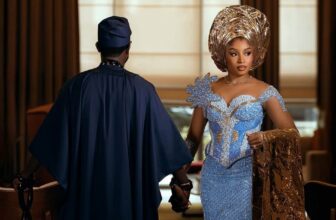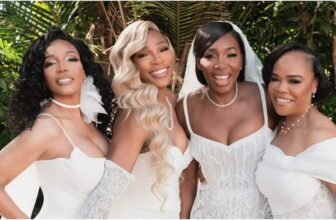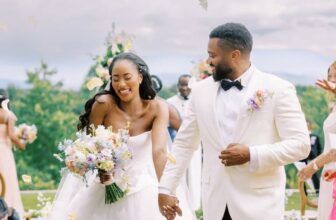Ghana, the vibrant West African nation, boasts a diverse cultural tapestry, numerous languages, and traditions that are truly one-of-a-kind. Despite its rich diversity, Ghanaian weddings have maintained a consistent charm throughout history, with recent years witnessing subtle modernizations. A Ghanaian traditional wedding is a captivating spectacle, showcasing unique customs that are deeply rooted in the nation’s history.
While the exact origins of these traditions remain unclear, Ghana has preserved and evolved its wedding customs over the years. The journey to marriage typically begins with men proposing after two to three dates, as an extended friendship is perceived as “taking advantage” in accordance with their beliefs. Once engaged, the pre-wedding festivities commence, featuring ceremonies and the exchange of gifts.
Annually, thousands of couples embark on the journey of marriage in Ghana, where an estimated 45 percent of men and 57 percent of women are either married or in union. The country recognizes three primary forms of marriage protected by law: civil, customary, and religious marriages. Other forms like symbolic, secular, and common-law marriages, though practiced, lack full legal validity.
In Ghana, common-law marriage, characterized by cohabitation or informal unions, is acknowledged under specific circumstances. A couple living together and presenting themselves as husband and wife over an extended period might be considered legally married, even without a formal ceremony. However, the legal recognition of common-law marriage varies based on circumstances and jurisdiction.
Ghanaian weddings are steeped in rich traditions, and while some customs are widely recognized, numerous hidden traditions often escape the spotlight. These lesser-known practices add depth and cultural significance to the celebration, making Ghanaian weddings truly unique.
Keep reading to discover the 10 intriguing things we’d like you to know about Ghanaian weddings.
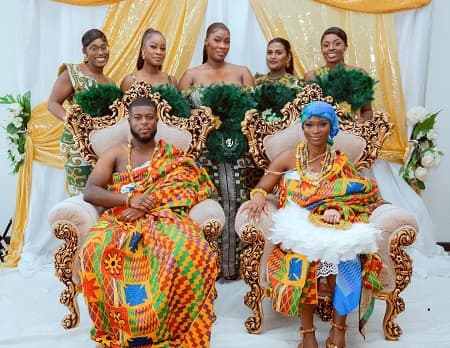
Opon-akyi bo (Knocking on the door)
In the lead-up to a Ghana traditional wedding, an essential ceremony called the “knocking” ceremony (kokooko or “Opon-akyi bo”) takes place. The term “kokooko” or “opon-akyi-bo” is traditionally associated with the Akan tribe.
In the Ewe ethnic group, it is referred to as “vofofo,” and among the Ga-Adangbes, it goes by the name “Agboshimo.” This ceremony involves the family of the groom “knocking on the door” or formally approaching the bride’s family to convey their son’s intention to marry their daughter. This serves as a crucial introduction between the two families.
It’s essential to note that this ceremony does not coincide with the actual wedding day. Instead, it occurs separately. The moment when the dowry list is presented to the groom-to-be’s family marks this occasion. Subsequently, the family prepares and gathers the specified items for presentation on the day of the traditional wedding.
Traditional Wedding Attire
The newlyweds-to-be adorn themselves in resplendent attire for their Ghanaian wedding. Traditional Ghanaian wedding garments often feature brightly colored and intricately patterned or embroidered kente fabric, following the traditions of African fashion.
Kente fabric, crafted from handwoven silk and cotton, takes center stage, complemented by exquisite gold jewelry. During the wedding ceremony, the bride may wear a traditional headdress, at times resembling a crown.
 Photo: Instagram.com/@_smiles_studios_
Photo: Instagram.com/@_smiles_studios_ In addition to dressing in the vibrant Kente cloth paired with elegant gold jewelry, an essential and remarkable accessory not to be overlooked is the exquisite glass beads. Both the bride and groom are adorned with necklaces and bracelets crafted from these intricate beads. In some instances, the bride also embellishes her headdress, waist, and ankles with these captivating beads.
One cannot overlook the exquisite “ahenema.” Ahenema is a traditional footwear, available in various colors and designs, radiates elegance, bestowing upon the bride and groom an air of regality like a king or queen.
The traditional wedding attire isn’t limited to the couple; “adinkra” symbols and kente cloth may also make appearances in the overall décor and table arrangements, adding a touch of cultural richness to the celebration. It’s important to note that while the term “adinkra” originates from the Akan ethnic group, it is referred to as “Evedzesiwo” among the Ewes and “Ga Samai” among the Ga-Adangbes.
Akonta Sikan
The term “akonta,” commonly employed by the Akan and Ewe ethnic groups, directly translates to brother-in-law. Consequently, this monetary gift is specifically presented to the brothers of the bride. In instances where a brother is absent, it is extended to male cousins, symbolizing gratitude for their protective role over the bride.
Drumming and Dancing
No discussion of a Ghanaian traditional wedding is complete without mentioning the vibrant elements of drumming and dancing. The ceremony is enriched by an abundance of traditional drumming, accompanied by various indigenous instruments. These rhythms are intertwined with meaningful gestures, complemented by customary dances such as the “adowa” and “kete” from the Akans, the “borborbor” and “agbadza” of the Ewes, and the “kpanlogo” and “gome” of the Ga-Adangbes.
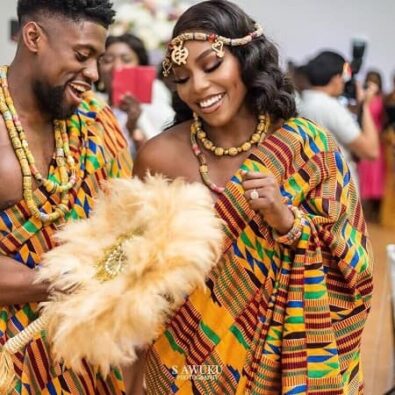
Okyeame
In Ghanaian traditional weddings, direct communication between the families of the groom and the bride-to-be is absent. Instead, both sides engage two linguists known as “okyeame.” Each “okyeame” serves as a representative and spokesperson for their respective family, facilitating communication between the two families.
These representatives from both families engage in a lighthearted and symbolic negotiation. The head of the bride’s clan or tribe, usually the eldest relative from her father’s side, sits alongside a spokesperson from her family.
On the other side, the groom’s family is represented similarly. These appointed spokespeople engage in playful banter, symbolically discussing the official request for the bride’s hand in marriage. This isn’t a formal meeting, but a jovial exchange where both sides enjoy playful teasing and light-hearted conversation.
Consent Tradition
In the Ghanaian wedding tradition, a symbolic aspect involves the bride giving her consent to marriage three times. This signifies her confident decision and ensures she is willingly entering the union. Despite its antiquity, this tradition persists in modern weddings, becoming a meaningful part of the ceremony. After accepting the proposal, the bride is formally introduced to the groom’s family, witnessed by all present.
Tiri Nsa Ritual
Originating from the Akan tribe, “tiri” signifies head, while “nsa” translates to drink, thus forming “head drink.” This segment involves the presentation of beverages, typically schnapps and potent gins, by the “abusuapanyin” (family head) from the groom’s family to the bride’s family. These drinks accompany additional gifts for the bride’s father, mother-in-law, and the bride herself.
It holds significant importance in the marriage process, symbolizing acceptance and the finalization of the union, as previously mentioned. In the event of a divorce, the return of these drinks to the groom’s family is necessary for the divorce to be officially recognized.
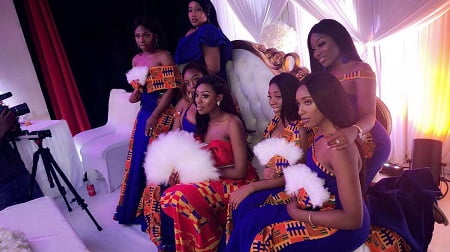
Fake Brides
A group of “fake brides” are presented to the groom, concealing their heads. This humorous tradition ensures the groom recognizes the woman he truly loves. Despite the playful element, the groom and family are well aware of the joke, eliminating any chance of a mix-up. The real bride makes her entrance last, marking the official union between the two.
In this lighthearted tradition, the bride’s family often playfully requests money from the groom’s family, humorously asserting that the bride has ventured a considerable distance and will require the funds as transport fare to bring her back.
Wedding Arrangements
In traditional practice, the groom and his family cover all expenses, whereas the provision of food, drinks, and other consumables falls under the responsibility of the bride and her family. The groom and his family are treated as guests in the bride’s home, receiving hospitality akin to serving visitors in one’s own home.

Nansiung-Lika Tradition
Among some Ghanaian communities, like the Bulsa of Northern Ghana, a significant tradition known as Nansiung-Iika or “Closing of the Gate or Entrance” is observed. This ritual is deemed highly important as it symbolizes the lifelong union of a man and woman, lasting until death.
Typically performed after the wedding but before the woman becomes pregnant, it involves presenting items like a hen, cola, hoe, or sheep to the woman’s paternal family. Their acceptance signifies the completion of this sacred ritual.
This ritual serves as evidence that the groom has fulfilled all the essential marital rites and customs necessary to formalize the union with the woman, including the legal acknowledgment of all children resulting from the marriage.
Notably, many Bulsa men engage in this ritual only when they are confident that the woman is capable of bearing children and is committed to a lifelong marriage.
As a precaution, most men wait until the woman has given birth to a few children before completing this ritual. Performing the rite when the wife is pregnant is deemed taboo. The ceremonial items may include a hen, cola, a hoe, or sheep. The woman’s paternal family accepting these items signifies the completion of the ritual.
Photo Courtesy
You May Also Like:
How Much Time Do You Really Need to Plan a Wedding?
December 30, 2025The Ultimate Guide To Your Honeymoon Packing List
December 16, 20258 Nigerian Weddings that Lived Up to the Hype in 2025
December 8, 2025How Long Should You Date Before Getting Engaged?
October 21, 2025Inside Eve Esin's Glamorous Nigerian-Ghanaian Wedding
October 20, 2025The Nigerian Tribes with the Most Expensive Bride Price
October 18, 2025How Long is Too Long to Get Married After a Proposal?
October 10, 2025Civil or White Wedding: Which One is Right for You?
October 9, 2025Who Should Pay the Bills at a Nigerian Wedding?
October 3, 2025This Fashion Designer is Turning Wedding Bouquets into Cute Handbags
September 29, 2025Selena Gomez Wore a Romantic Ralph Lauren Wedding Gown to Marry Benny Blanco
September 28, 202511 Best Wedding Planners in Nigeria to Bookmark
September 21, 2025Esther Ejoh is a Fashion Editor at Fashion Police Nigeria, where she writes all things fashion, beauty, and celebrity style, with a sharp eye and an even sharper pen. She’s the girl who’ll break down a Met Gala look one minute, rave about a Nigerian beauty brand the next, and still find time to binge a movie or get lost in a novel. Style, storytelling, and self-care? That’s her holy trinity.



